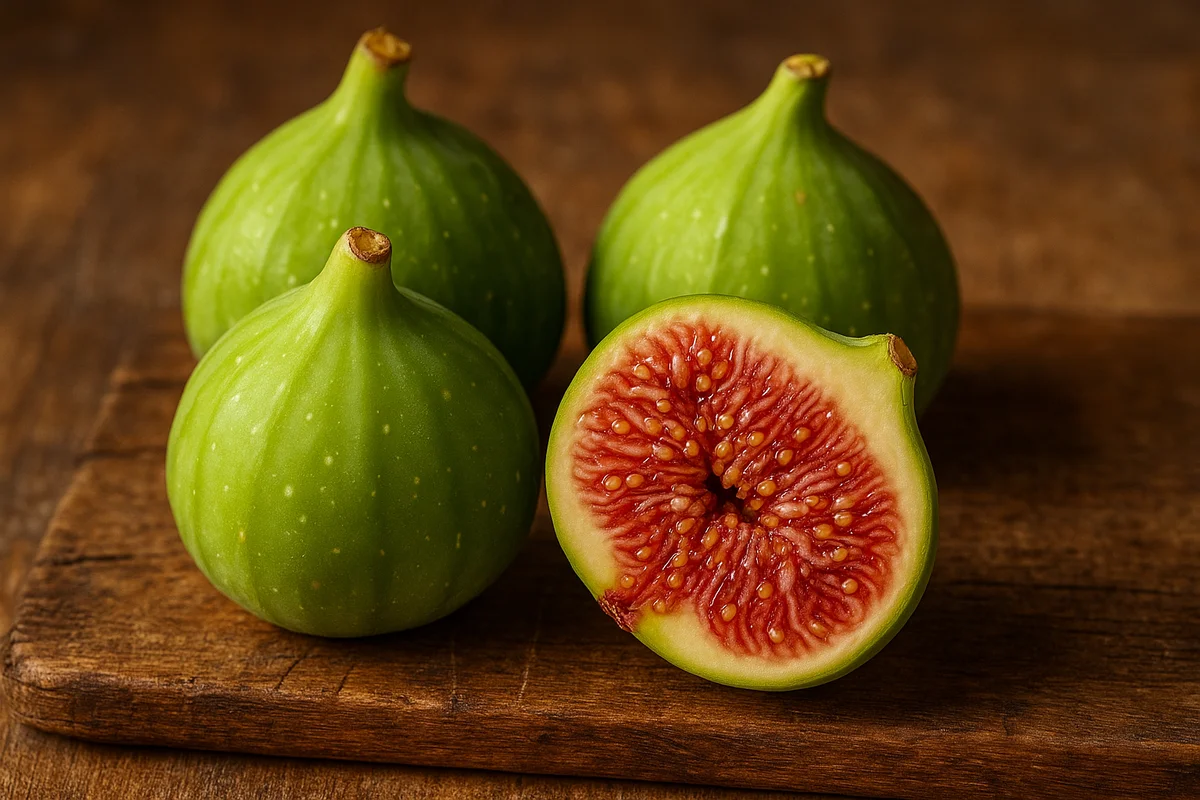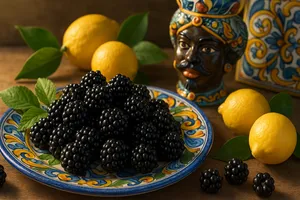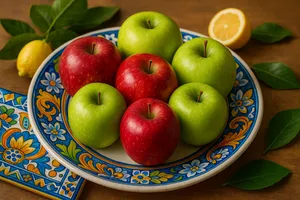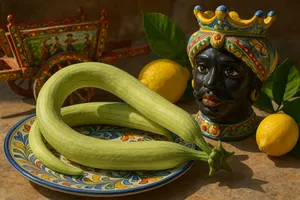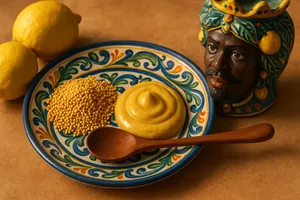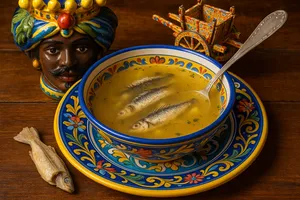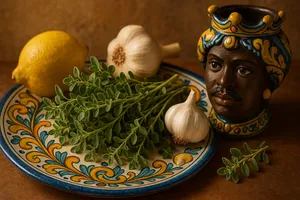Overview
Figs are the fruit of the fig tree (Ficus carica), an age-old species cultivated in Sicily since the time of the Phoenicians and Greeks. These sweet, juicy fruits, with their distinctive shape and soft, sugary flesh, are one of the symbols of the Sicilian summer and hold an important place in both the island’s cookery and its popular culture.
In Sicilian tradition, figs are central to countless preparations: eaten fresh as a luscious, refreshing fruit; sun-dried to be enjoyed all year round; stuffed with almonds and aromatics to create the famous “fichi mandorlati”; used in traditional sweets; or paired with cheeses in sweet-savory combinations. The fig tree was present in every farmhouse and garden, offering generous shade and abundant fruit, a symbol of prosperity and well-being.
Characteristics
Figs vary from pear-shaped to round, with sizes ranging from 4–5 centimetres up to 8–10 centimetres in the larger varieties. The skin, thin yet resilient, may be green, yellow-green, purple or dark violet depending on the variety and degree of ripeness.
The inner flesh is soft, juicy and very sweet, ranging in colour from white to pink to deep red, dotted with countless tiny crunchy seeds. The texture is creamy at perfect ripeness, with an intense, characteristic sweetness. The aroma is delicate, sweet and faintly musky.
At the tip of the fruit is the “eye”, a small opening which, when slightly ajar, indicates perfect ripeness. A fig at its prime yields gently to the touch, has intact skin without excessive splitting, and gives off a sweet aroma.
Varieties
Fioroni (first-crop figs)
Called “ficu fràulu” or “ficu timpuranìu” in Sicilian, these are the first figs of the season, ripening between late May and June. They are generally larger, with less sweet flesh and fewer seeds than true figs. They are appreciated for their early ripening.
Dottato
A very widespread variety in Sicily, with yellow-green skin and amber, very sweet flesh. It has a roundish shape and medium-large size. Excellent fresh or dried. It is the main variety used for high-quality dried figs.
Verdello
A green-skinned variety that ripens late, even in autumn. It has red flesh and a very sweet flavour. It withstands high summer temperatures well and is valued for its extended production.
Black fig
With dark purple or violet-black skin and deep red flesh. It has a very sweet, aromatic flavour. Particularly appreciated fresh and for jam.
White fig of Cilento
A variety with light green skin and pale amber flesh. Very sweet and delicate, excellent fresh but also ideal for drying. Also cultivated in Sicily.
Seasonality
In Sicily, fig season begins in late May–June with the fioroni (first crop) and continues with true figs from July to September–October depending on the variety. Peak production occurs between July and August, when figs are most abundant, sweet and fragrant.
Late varieties such as verdello extend the season well into autumn. In favourable conditions, a fig tree can bear fruit for several months, offering staggered harvests that ensure prolonged availability.
Fresh figs in cookery
Fresh figs feature in numerous Sicilian preparations.
Enjoyed naturally
The simplest and most appreciated way is to eat figs fresh, just picked or well chilled from the refrigerator. In Sicily it is traditional to serve them as a summer dessert, often with a slice of melon.
Figs with prosciutto
A classic sweet-savory pairing in which ripe fresh figs are matched with cured ham. It is an elegant starter that enhances both ingredients.
Figs with cheese
Figs pair beautifully with fresh cheeses such as ricotta and goat’s cheese, or with mature varieties like pecorino and Parmesan. They are key elements on summer cheese boards.
Salads
Fresh figs cut into wedges enrich mixed salads, paired with rocket, walnuts, goat’s cheese and balsamic vinegar. Ideal for sophisticated summer salads.
Fig jam
Fresh figs are cooked with sugar and lemon to create a dense, fragrant jam, excellent for filling tarts and biscuits or spreading on bread.
Dried figs
Drying figs is an ancient Sicilian tradition, a method of preservation that allowed these fruits to be enjoyed year-round.
Traditional preparation
Ripe figs are split open or left whole, arranged on mats or racks and exposed to the Sicilian sun for several days, turning them periodically. Drying concentrates the sugars, making them even sweeter. Once dried, they are stored in airtight containers.
Fichi mandorlati
A Sicilian speciality in which dried figs are stuffed with toasted almonds, walnuts, candied orange or lemon peel, cloves, and sometimes coated in chocolate. They are then briefly baked. These are traditional Christmas sweets.
Crocette di fichi
Dried figs are opened in a cross shape, filled with almonds and aromatics, then closed and lightly pressed. They are briefly baked and served as small treats.
Buccellato
A Sicilian Christmas cake in the form of a ring, filled with a mixture of chopped dried figs, almonds, raisins, honey, candied fruit and spices. Dried figs are essential to the filling.
Preparation
Fresh figs can be eaten with or without the skin. The skin is entirely edible, though some prefer to peel them, especially thicker-skinned varieties. To peel, make a cut from top to bottom and gently remove the skin.
For cooked preparations, figs should be washed gently, dried and cut in half or into wedges. For jam, they may be cut into smaller pieces. There is no need to remove the seeds, which are tiny and edible.
To dry them at home, choose ripe but firm figs, wash and dry them, cut them in half and place them on racks in a sunny, well-ventilated spot, turning them daily until completely dry (7–10 days).
Storage
Fresh figs are very delicate and perishable. They keep in the refrigerator for up to 2–3 days, arranged in a single layer on a plate or in a perforated container. They should not be washed before storage but only just before eating.
Over-ripe figs should be consumed immediately as they spoil quickly. They can be frozen: halved, placed on trays and frozen, then transferred to bags. They keep for 6–8 months and are excellent for jams and desserts.
Dried figs keep for many months in airtight containers stored in a cool, dry place, away from humidity and insects. Some people store them layered with bay leaves to keep pests away.
Buying tips
When buying fresh figs, choose fruits with intact skin, soft to the touch but not mushy or split. The fig should yield slightly to pressure. The eye should be slightly open, indicating ripeness, but not too wide, which may signal over-ripeness or early fermentation.
The aroma should be sweet and pleasant. Avoid figs with a sour or fermented smell, dark spots, mould or bruises. Prefer local, in-season figs, harvested ripe because they do not ripen further after picking.
For dried figs, choose fruits that are soft and pliable, not too hard or overly dry. They should have a uniform colour without white spots (which may be mould or excessive sugar crystallisation) and a sweet aroma.
Nutritional properties
Fresh figs provide about 47 calories per 100 grams. They are composed of around 80% water and contain about 12 grams of carbohydrates per 100 grams, mainly simple sugars (fructose and glucose). Protein and fat content is very low.
They are a good source of fibre (around 2–3 grams per 100 grams), important for intestinal regularity. They contain vitamins, particularly vitamin K, vitamin B6 and small amounts of vitamin C. They are rich in minerals such as potassium, calcium, magnesium and iron.
Dried figs are far more caloric (around 250 calories per 100 grams) because their sugars are concentrated. They also contain much higher levels of fibre, vitamins and minerals. They are energy-dense and nutritious, ideal for athletes.
In Sicilian folk medicine, figs were considered nourishing, laxative and beneficial for the throat. The tree’s latex was used to remove warts and calluses.
Curiosities
The fig tree is one of the oldest domesticated by humankind. In Sicily it has been present for millennia, probably introduced by the Phoenicians. It was regarded as a sacred tree in several ancient Mediterranean cultures.
In Sicilian tradition, a fig tree planted in front of the house brought luck and prosperity. Its generous shade was a place of gathering and rest during the hot summer days. Many dealings and negotiations concluded “under the fig tree”.
Dried figs were considered “the poor man’s sweet”, available all year and nourishing. During winter, especially at Christmas, they were shaped into elaborate forms to create confections that less wealthy families could proudly offer.
The white latex that exudes from unripe figs was used in folk medicine for various applications. It was believed to have healing properties, though in reality it may cause skin irritation in sensitive individuals.

